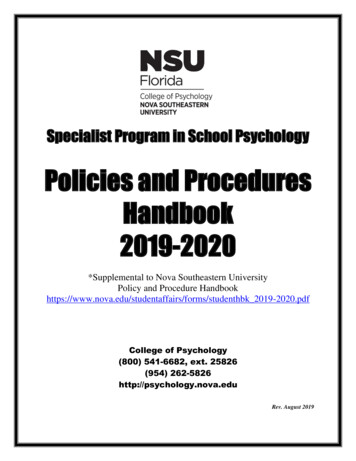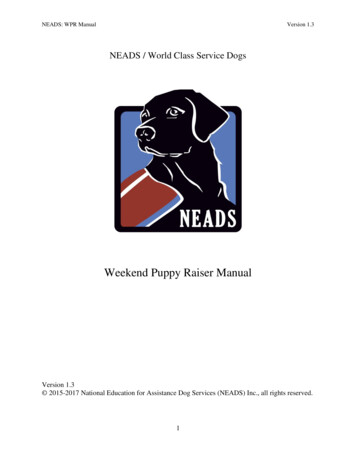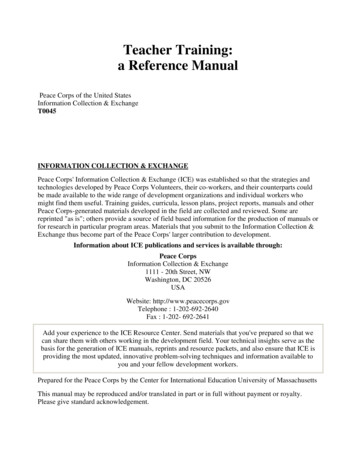
Transcription
EMDR Institute Inc.WEEKEND 1 TRAINING MANUALOFTHE TWO PARTEMDR BASIC TRAINING
AGENDADAY :00-1:00pm1:00 LectureBREAKLectureLUNCHPractice Session 1Groups of 9-10Triads(15 minute break in Triad)Debrief-Groups of 9-10DAY pmREGISTRATIONLectureBREAKLectureLUNCHPractice Session 2Groups of 9-10Triads(15 minute break in Triad)Debrief-Groups of 9-10DAY LUNCHPractice Session 3Groups of 9-10Practice AssignmentsTriads(15 minute break in Triad)Getting Started, Wrap-up/Closure
TABLE OF CONTENTSIntroduction and Training GoalsThe EMDR CommunityBackground of EMDRMechanism, Model and MethodologyThe EMDR Approach to PsychotherapyEight-Phases of EMDR TreatmentPhase One: History-TakingProcedures to Identify Memories for ReprocessingEMDR Psychosocial Interview AgendaDeveloping an AIP-Informed Treatment PlanExamples of Negative and Positive CognitionsPhase Two: PreparationDeveloping and Enhancing a Calm/Safe PlaceDay 2 ReviewPhase Three: AssessmentPhase Four: DesensitizationPhase Five: InstallationPhase Six: Body ScanPhase Seven: ClosureDay 3 ReviewFacilitating Blocked ProcessingStabilization and Resource Development InterventionsAdditional Stress Management StrategiesPhase Eight: ReevaluationResuming Reprocessing of an Unfinished TargetCompleting the Treatment PlanReprocessing Present TriggersFuture TemplatesProcedural Steps for Future TemplatesRecent Traumatic EventsWorking with Children Using EMDRAppendixCertificate of CompletionConsultation for Basic Training-Participant GuidelinesEvaluation and Consultation Sign-Off FormParticipant Skills ChecklistConsultation for Basic Training-Consultant GuidelinesSkills Checklist for ConsultantWeekend 1 Forms for Clinical PracticeClient Selection Criteria ChecklistHistory-Taking and Treatment Plan WorksheetPhase Two: Preparation ChecklistDeveloping and Enhancing a Calm/Safe PlacePhase Three: Assessment WorksheetReprocessing Procedures Phases 4-7Treatment Summary NotesPhase Eight: ReevaluationTreatment Plan ConsiderationsProcedural Steps for Installing Future TemplatesGlossary of EMDR TermsOverview of the Eight Phases of EMDR TreatmentAnswers to Procedural Steps QuestionsFuture Template Flow ChartCommon Mistakes in the Applicationof the Standard EMDR ProtocolEMDR in Clinical Practice: Understanding andManaging Clinicians’ Resistance and 394959798107
Basic Grounding Skills for Use with ClientsWho are Dysregulated and DissociativeEMDR: Symptom Reduction orComprehensive TreatmentTreatment Planning GuideSample Acknowledgment and Consent FormSample Single Incident-Trauma Client HistoryCase Conceptualization with ChildrenEMDR Child Assessment FormsAnnotated Bibliography of Research on EMDR InIndividual and Group Psychotherapy with ChildrenEMDR with a Traumatized ChildImpact of Event Scale-RevisedClinical Signs of Dissociative DisordersManual for the Dissociative Experience ScaleDESA General Guide to the Use ofEMDR in the Dissociative DisordersAdditional Stress Management StrategiesEMDR Evaluated Clinical ApplicationsEMDR: Trauma Research Findings and Further ReadingResearch on the Role of Eye MovementsHow Are the Eye Movements Helpful in EMDR?Clinical Research ProtocolsEMDR Treatment of Phobias-Research OverviewEMDR Institute Internet Discussion ListBook and Video Purchase FormEMDR Humanitarian Assistance ProgramsEMDR HAP StoreEMDR International Association (EMDRIA)NeurotekEMDR No Fee Networking GroupsFacilitator Consultation 57159175197200203205209210212213214215216219
INTRODUCTION AND TRAINING GOALSBASIC TRAINING-50 hours 20 hours of lecture 20 hours of practice 10 hours of consultationWEEKEND 1 TRAINING 20 HOURSGoals To provide an understanding of the EMDR Approach To provide sufficient knowledge and practice using EMDRDay 1 Overview of EMDR Adaptive Information Processing Model (AIP) Practice Session Day 1-Preparation and History-TakingDay 2 In-depth discussion of reprocessing procedures Practice Session Day 2-EMDR Reprocessing of selected memoryDay 3 Recent Trauma Eight Phases with Children Practice Session Day 3-Reevaluation of selected memoryCASE CONSULTATION WITH EMDR INSTITUTE FACILITATORSee EMDR Institute Facilitator/Consultant Listing in back of manual 5 hours completed between Weekend 1 and Weekend 2 5 hours after completion of Weekend 2WEEKEND 2 TRAINING-20 HOURSExpand knowledge of EMDR to include: Additional Treatment Plan strategies Case Conceptualization for more complex presentations Expand Resource Development interventions Application of Cognitive Interweave Introduce using EMDR with:o Recent traumao Dissociationo Phobiaso Somatic disorderso Special populationsCERTIFICATE OF COMPLETION ISSUED Upon completion of the Basic Training Course1
THE EMDR COMMUNITYEMDR INSTITUTE INC-www.emdr.com Training InstituteFounded by Francine Shapiro, Ph.D.Domestic and International Training SchedulesContinuing EducationResearch SummariesListing of EMDR Institute-trained CliniciansResource for Frequently Asked Questions & AnswersEMDR Bookstore and Clinical AidsElectronic Discussion List for EMDR Institute-trained CliniciansInternational OrganizationsEMDR INTERNATIONAL ASSOCIATION (EMDRIA)-www.emdria.org Non-Profit Professional AssociationTraining StandardsCertificationEMDR International ConferenceRegional MeetingsMembership DirectoryNewsletterPeer reviewed Journal of EMDR Practice & ResearchResearch SummariesSpecial Interest Internet Discussion GroupsFrancine Shapiro LibraryEMDR HUMANITARIAN ASSISTANCE PROGRAMS (HAP) www.emdrhap.org Non-Profit ProgramsVolunteer BasedDisaster Response Network (Domestic and International)Low Fee EMDR Trainings for Non-Profit Agencies/OrganizationsBookstore2
BACKGROUND OF EMDRChapter 1 (Shapiro, 2001)DISCOVERY1987 Discovery of the effects of spontaneous eye movement Developed procedures around effects of eye movement1989 First controlled treatment outcome study of EMDR for PTSD published in the Journal ofTraumatic Stress First controlled studies of prolonged exposure therapy, psychodynamic therapy, andhypnosis for treatment of PTSD1990 EMD becomes EMDR Discovered other forms of bilateral stimulation (tactile taps, tones)RESEARCH-SEE APPENDIXCONTROLLED OUTCOME STUDIES (See Appendix) Over a dozen randomized controlled treatment outcome studies of PTSDTypically 3-6 sessions; 77-100% remission of PTSD with single traumavictims12 or more sessions needed for multiple trauma victims, such as combat veteransEMDR compared to Prozac indicates EMDR superior with patients becoming improvedeven after termination of therapy, while many Prozac patients again becamesymptomatic (van der Kolk et al., 2007)While 90 minute sessions are suggested, 50 minute sessions can also be used (Marcuset al., 1997, 2004)For positive results there is a need for adequate fidelity and treatment doseMeta-analysis (Maxfield & Hyer, 2002) indicated that the more rigorous the study, thelarger the effect sizes3
COMPONENT ANALYSES Clinical component analyses have been equivocal due to variety ofmethodological problemsComponent studies testing variety of neurobiological hypotheses have supportedtheories of working memory, orienting response, reciprocal inhibition and REM (readChapter 12 for comprehensive review)META-ANALYSES (See Appendix) Combination of all controlled studiesEqual treatment effect sizes when measuring overt symptoms of PTSD for EMDR andexposure therapies (although EMDR studies include those with insufficient treatmentdoses for combat veterans)EMDR uses no homework to treat the trauma while exposure therapies use 1-2 hours ofdaily imaginal and/or in vivo homeworkACUTE ONGOING TRAUMA IN CHILDREN Outcome: increased resiliencyZagrout-Hodall, Alissa & Dodgson (2008)INTERNATIONAL TREATMENT GUIDELINES (See Appendix) American Psychiatric Association (2004). EMDR recommended as effective in thetreatment of trauma Bleich, Kutz & Shalev (Israeli National Council for Mental Health, 2002)EMDR is one of only three methods recommended for treatment of terrorvictims Department of Veterans Affairs & Department of Defense (2004). EMDR was placed inthe A category for the treatment of intense trauma National Institute for Clinical Excellence (2005). Trauma-focused CBT and EMDR werestated to be empirically supported treatments of choice for adult PTSD4
MECHANISM, MODEL AND METHODOLOGYMECHANISM Neurobiological underpinnings-unknown for any form of psychotherapyEight studies indicated eye movements have effects on memory(retrieval, vividness, emotional arousal, etc.)Orienting response/working memory, REMSee AppendixMODEL Information Processing ModelIndependent of any particular neurobiological mechanismInterprets clinical phenomenaPredicts successful applicationGuides clinical practicePTSD scores higher after life events (t) than after traumatic events (T) (Mol,Metsemakers, Dinant, Viters-Van Montfort, 2005)Survey of 832 people for events within past 30 years“T”-meet Criteria “A” for PTSD“t”-life event with equal or greater impact on presenting problem/ pathologyMETHODOLOGY Eight Phases of EMDR TreatmentStandard procedures guided by articulated principlesLargest treatment effects were shown in studies with rigorous designs that maintainedfidelity to the EMDR procedures (Maxfield & Hyer, 2002)5
THE EMDR APPROACH TO PSYCHOTHERAPYChapter 2 (Shapiro, 2001)Bilateral stimulation (eye movements, tactile taps, auditory tones) is merely one component ofEMDR.EMDR is a distinct integrative treatment approach with eight-phases that is compatible with allthe major orientations to psychotherapy.Different diagnoses require different, often customized EMDR procedures which incorporatethe three-pronged protocol of past, present, and future.EMDR is used to address disturbing life experiences that contribute to clinical problems andhealth.EMDR is a comprehensive psychotherapy approach (distinct from psychodynamic, CBT,experiential, etc.) guided by an information processing model of learning.THE ADAPTIVE INFORMATION PROCESSING MODEL(see also Shapiro, 2001, 2006) The cornerstone of the EMDR approach: memory networks are the basis of clinicalsymptoms and of mental healthExcluding situations caused by inadequate information/organic deficits, unprocessedmemories are the primary basis of pathologyFoundation of all EMDR phases, procedures and protocolsBasis of understanding developmental and clinical phenomenaGuides case conceptualization and treatment planningPredicts positive treatment outcomesCOMPONENTS OF THE ADAPTIVE INFORMATION PROCESSING MODEL Physical information processing system, like other body systems, is geared towardhealthPhysical example: cut closes and heals unless blockedEmotional example: The information processing system moves disturbances to anadaptive resolution, thereby creating functional memories and memory networks6
Disruptions to the information processing system result in disturbing memories that aredysfunctionally stored as they were experienced and perceived at the time of the eventAs the perceptions of the present link to the memory networks, various components ofthe previously unprocessed memories are experienced (e.g., emotions, physicalsensations, thoughts/beliefs) –Triggers“The past is present”: Perceptions of current situations link into the networks ofphysically stored memories in order to be interpreted. If a memory network contains anunprocessed memory, the current perceptions are informed by the earlier dysfunctionalemotions, thoughts/beliefs, sensations of the past event(s)Processing is viewed as the forging of adaptive associations between networks ofinformation stored in the brainEMDR facilitates an associative process that allows the relevant connections to bemadeThe unprocessed components/manifestations of memory (image, thoughts/sounds,emotions, physical sensations, beliefs) change/transmute during processing to anadaptive resolutionWhat is useful is stored, available to inform future experiences; what is no longeradaptive is discarded (e.g., physical sensations, irrational beliefs)Memory networks are viewed as the underlying basis of pathology and mental healthDisruptions of processing may be caused by high levels of disturbing emotions–canblock experiences from being adaptively processedExamples:Early childhood attachment issues:o Childhood trauma or neglecto “t” life eventso “T” criterion “A”1. Childhood humiliation experiences2. Accidents/Injuries/Illness3. Loss of parent/sibling or significant other4.5.7
EXPERIENTIAL CONTRIBUTORSWe use the term “trauma” to refer to the ubiquitous life experiences that have a lasting,ongoing impact on people in order to sensitize clinicians to this notion.EMDR targets the memories that contribute to dysfunction and to health.COMPONENTS OF MEMORY STORED INFORMATION Sensory Input (images, sounds, smells, tastes)ThoughtsEmotionsBody SensationsBeliefsMemory Networks: Memories with similar information (senses, thoughts, emotions, body sensations andbeliefs) are linked by their channels of associationAdaptive memory networks are the primary basis of learning, self-esteem, and otherpositive resources and behaviorsMaladaptive/dysfunctional memory networks are the primary basis of pathologyMaladaptively stored memories are etiological to client’s presenting concernsMemory networks form the basis arget The node is the memory designated for therapeutic targeting. It is a biologically storedexperience, which represents a memory network Touchstone Memory–earliest recalled experience that laid the foundation for the client’spresenting problem Memories are considered “dysfunctional” because they are physiologically stored in away that does not allow them to link to any positive/adaptive networks8
EMDR PROCEDURES ACTIVATE THE TARGET MEMORY AND STIMULATE THEADAPTIVE INFORMATION PROCESSING SYSTEM Negative, disturbing memories that are inadequately processed are reprocessedProcessed memories are integrated into adaptive memory networksENHANCEMENT AND DEVELOPMENT OF POSITIVE NETWORKS Positive memory networks need to be present and accessible for reprocessing to occurPositive life experiences and adaptive memories (senses, thoughts, emotions, physicalsensations, beliefs), when accessed, are strengthened and enhanced through theaddition of BLSTherapeutic relationship as a positive memory networkREPROCESSING Maladaptive/dysfunctional memory networks, when accessed and processed, link withexisting positive, adaptive, and functional memory networkso Accessing experiences (positive and negative) allows for the linkages betweenconsciousness and where information is stored.o EMDR- activated processing is metaphorically like moving down a train track towardsa more adaptive/functional resolution.o Each stop allows linkage to existing adaptive positive networks.BY-PRODUCTS OF EMDR- ACTIVATED ADAPTIVE INFORMATION REPROCESSING Desensitization of emotional and physical disturbanceEmergence of insight and positive changes in physical and emotional responsesIntegration: new learning becomes available in the current life contextEMDR IS AN INTEGRATIVE PSYCHOTHERAPY APPROACHInterventions, such as, self-soothing techniques or the development of new skills can beincluded in EMDR therapy using the precepts of the AIP Model. Additional interventions maybe needed to provide comprehensive treatment or to fully assimilate changes that occur duringEMDR reprocessing. They are all applied through an understanding of the AIP model.Dysfunctional memory networks are reprocessed and positive ones are integrated andenhanced.9
Self-regulation skills - external and internal challenges to emotional stability and currentlevel of functioning (add or enhance access to positive networks)Skills building - fill in developmental deficits or learning specific skills (develop positivememories which incorporate new learning)EMDR is compatible with elements of other clinical approaches. However, it is a distinctform of psychotherapy which directly addresses the physiologically stored memories.Changes in the present occur because of the reprocessing of the targeted memorynetworks.EMDR therapists come from various theoretical approaches and backgrounds.Practitioners from all orientations can successfully integrate EMDR principles andprocedures into their clinical practice.GOAL OF THE EMDR APPROACH TO PSYCHOTHERAPY To achieve the most effective and efficient treatment effects while maintaining clientsafetyTo achieve appropriate, adaptive and ecological resolution of presenting problemsTo incorporate new skills, behaviors and beliefs about self, optimizing clients’ capacityto respond adaptively in the current context of their livesEMDR ACTIVATING COMPONENTS Access “frozen” dysfunctional memoryStimulate the information processing system (keep it dynamic)Move information to adaptive (appropriate/positive) resolutionREPROCESSING LEARNING10
EIGHT PHASES OF EMDR TREATMENT Phase One: History Phase Two: Preparation Phase Three: Assessment Phase Four: Desensitization Phase Five: Installation Phase Six: Body Scan Phase Seven: Closure Phase Eight: Reevaluation11
PHASE ONE: HISTORY-TAKINGChapter 4 (Shapiro, 2001)GOALSTo gather customary information about the client via the therapist's usual history-taking and toprovide the client with all information typically required for informed consent.To consider special EMDR criteria related to client selection and readinessTo identify potential treatment targets from positive and negative events in the client's life(past, present, future).OVERVIEWEMDR Treatment Plan as part of a comprehensive treatment planEvaluate:– Client’s integrative capacity– Affect tolerance– Current internal and external resources– Attachment history– Readiness for change– Current psychosocial factors– Level of complexity/resources determine paceAIP- INFORMED CASE CONCEPTUALIZATION Current symptoms are caused by earlier experiences that were not adequatelyprocessed due to trauma or insufficient information.What experiences have set the groundwork for pathology? Trace present reactions topast experiences.Assess strengths as well as developmental deficits and establish the necessaryconditions to move the client toward health.What memories need to be targeted that will fill in deficits and bring the client to health?Identify needed skills and behaviors.Is the client able to access the experiences and allow reprocessing to occur?Conduct Psychosocial/Diagnostic Intake Interview to evaluate the clinical landscape,self-soothing skills, and readiness for EMDR processing. When clinically appropriate,gather information necessary for EMDR case conceptualization and TreatmentPlanning.o Information may include early childhood strengths and resources as well as negativeevents–abuse and/or neglect, problems with significant attachment figures,developmental milestone deficits.12
o Develop collaboratively with the client, a Treatment Plan consistent with theirtreatment goals.POSSIBLE CLINICAL PRESENTATIONS (in order of complexity): Single Incident Presentations:1. Acute Stress Response: An acute traumatic event (“T”) that occurred within a fewdays and is represented by a set of symptoms that are directly related to a singleevent.2. Recent Event: A traumatic event that occurred within a two-to-three month period. Single Dominant Issue/Symptom:1. A disturbing life event or a series of events that are organized around one dominanttheme represented by a single symptom such as, a core negative belief, pervasiveemotional state, body sensation, pattern of behavior, etc. May be exacerbated by ‘t’events from early childhood.2. Posttraumatic Stress Disorder (PTSD): A disturbing life event (“T”) or series ofevents over a prolonged period that meets DSM Criterion A for PTSD. Client suffersfrom intrusions, hyper arousal, and/or avoidance of stimuli that trigger negativesymptoms. Origin may be in adulthood or early childhood experiences to include:a. Accident(s)b. Major life changes (e.g., loss of loved one, serious illness or injury to self orother)c. Physical or sexual assaultd. Ware. Natural disasters Multiple Issues/Symptoms Presentations:1. Depression, anxiety, panic reactions, interpersonal problems,some dissociativeprocesses, less severe characterological issues. Numerous experiences over timehave produced pathology, but client does not meet the full diagnostic criteria forPTSD.2. Complex PTSD: Complex presentation of traumatic life events, extreme stress overa prolonged period of time. Symptoms may include more severe personality anddissociative phenomena. More preparation required. Note: Complete EMDR BasicCourse with specialty training in the field.13
o Depth and comprehensiveness of history-taking determined by the client’sinternal and external resources (i.e., emotional regulation, affect tolerance, socialsupports, etc). Evaluate need for resource development and stabilization.o Use clinical judgment when inquiring about earlier events by evaluating theclient’s ability to maintain dual awareness without flooding or dissociating duringinterviewing.o Important to titrate history-taking over time while preparing for memoryprocessing work with EMDR.o Use clinical judgment to determine what memories to process and in what ordero Ongoing reevaluation of overall treatment plan and targeting sequence strategiesmay be necessary as treatment evolves.14
THREE-PRONGED PROTOCOL PASTo What etiological incident(s) set the groundwork for pathology (Touchstone memory,or other experiential contributor)?Link present reactions/symptoms to pastcontributing experiences.o What skills and behaviors are needed to stabilize and resource the client sufficientlyto begin reprocessing and adaptive learning? PRESENTo What present experiences are causing disturbing symptoms and reactions? FUTUREo What is the client’s positive vision for the future?o What is the client’s capacity to allow a positive, more adaptive set of responses to bedeveloped and acted upon?o What are the potential future challenges that could occur?15
PROCEDURES TO IDENTIFYMEMORIES FOR REPROCESSINGAIP: To access a memory or memories in a memory network that is the basis of theclient’s current dysfunction.GOAL: Identify earlier memories within the identified memory network; can be usedduring History-taking; to identify a feeder memory during processing; to bring to awarenessa memory causing a blocking belief, etc.,Asking clients to access a current experience of the problem; identifying earlier experiencesthat are similar or relate in some way that can be targeted for reprocessing.DIRECT QUESTIONINGFLOAT BACK TECHNIQUE (Browning & Zangwill)Uses the associational processes of the brain to access other memories that areconnected to the client’s current experience of the problem. Best to use during Historytaking with more highly resourced clients. Use caution with clients who have pervasivehistory of abuse or neglect or who may be dissociative.“As you bring up the recent experience of , notice the image that comes tomind, the negative belief you’re having about yourself along with any emotions andsensations, and let your mind float back to an earlier time in your life when you mayhave felt this way before and just notice what comes to mind ”AFFECT SCAN (Shapiro, 1995: independently developed andhypnotic/reliving component contained in Watkins and Watkins, 1971).withouttheNote: Affect Scan is particularly useful to apply when the NC is unclear, when an earlymemory is not accessible by other means, and during reprocessing sessions whenclient’s process is stuck and you are checking for an earlier feeder memory.“Bring up that experience, the emotions and the sensations that you¹re having now, andallow yourself to scan back for the earliest time you experienced something similar.”16
EMDR PSYCHOSOCIAL INTERVIEW AGENDA(Client Selection Criteria)ADAPTIVE INFORMATION PROCESSINGExcluding situations caused by insufficient information/organic deficits, the cause of presentdysfunction is based in physiologically stored memories. Evaluate history accordingly.What targets have set the groundwork for pathology? Trace present reactions to pastexperiences.What targets will fill in deficits and bring the client to health-identify needed skills andbehaviors?Is the client able to access the experiences and allow processing to occur?PRESENTING COMPLAINT (ISSUE)CLIENT-CLINICIAN RELATIONSHIPTrust and safety have been established in the clinical relationship. Client agrees to giveclinician accurate feedback about client’s private internal experiences regarding thereprocessing of the memory.CLINICAL LANDSCAPEUse clinical judgment regarding the timing and pacing of gatheringinformation about early childhood attachment and development;life experiences, family of origin, peer relationships; cultural, gender,ethnic and religious influences.17
CHECKLIST: The following may be treated as a clinical checklist or worksheet:OKPCHas been addressed and is favorable for EMDR useProblem: Wait until completion of course or until further preparation and stabilizationhas occurred.Consultation indicated with EMDR clinician with expertise in area of concern.CLINICAL CONCERNSCLIENT STABILITY / DEVELOPMENTAL DEFICITS / ABILITY TO MANAGE STRESS OK PROBLEM CONSULTATIONClient has been screened for Dissociative Disorder. DD rules out use of EMDR byWeekend 1-trained clinicians. See Clinical Signs of Dissociative Disorders and DES inAppendix. In addition to a Mental Status Exam, the DES should be used for every client.Special preparation for DD clients is needed to establish their capacity to maintain dualawareness in order for reprocessing to occur. Indicators of poor psychic developmentinclude but are not limited to: Years of unsuccessful psychotherapyDepersonalization and/or derealizationMemory lapsesFlashbacks and intrusive thoughtsSomatic symptomsChronic instability at home and/or at workSecondary gain issues identified and appropriately addressed.Clinician and client have considered severity of issues which may be exacerbated based onhistory and clinical diagnosis.ACUTE PRESENTATIONS OK PROBLEM CONSULTATIONThe following situations require caution and case consultation: Life threatening substance abuseSerious suicide attemptsSelf-mutilationSerious assaultive behaviorDissociative disorders18
STABILIZATION OK PROBLEM CONSULTATION Adequate stabilization/self-control strategies in placeClient must have a workable means of dissipating disturbance ifor between sessionsClient has adequate life supports (friends, relatives, etc.)Systems/issues that might endanger client have been addressedClient able to call for help if indicatednecessaryduringMEDICAL CONSIDERATIONS OK PROBLEM CONSULTATIONGeneral physical health/medical condition/age considered (possibleexacerbation with stress)MedicationsInpatient if necessary to manage danger to client or othersEye pain contraindicates EMs until cleared by physician (use alternate forms ofstimulation)Any neurological impairment or physical complication inappropriate for Weekend 1/Part1 cliniciansTIMING CONSIDERATIONS/READINESS OK PROBLEM CONSULTATION Timing of life events (projects, demands, work schedules, vacations, etc)Availability of both therapist and client for support and/or follow-upWillingness/ability to continue treatment as indicated90 minute sessions (if possible)19
DEVELOPING AN AIP-INFORMED TREATMENT PLANSYMPTOM CLUSTERS THAT CAN BE USED TO ORGANIZE A TREATMENT PLAN: Irrational negative beliefs about self (Part One focus)BehaviorsEmotionsBody sensationsSenses (tastes, odors, sounds)People, places, or thingsOtherTHREE-PRONGED PROTOCOL Pasto First experience (Touchstone Memory)o Worst experienceo Other contributing past experiences Present Triggerso Current triggers that remain due to second-order conditioning (may need to betargeted separately)o Recent experiences that occur such as accidents, injuries that do not have ahistorical component but have generated symptoms that need to be treated Future Templateso Desired outcomes for the future; preparation for potential challengeso Anticipatory anxietieso Develop alternative patterns of response that are more adaptive to the clientIRRATIONAL BELIEFS ABOUT THE SELFDistorted conclusions about the self are based on the disturbing affects and the incomplete orinaccurate information that was available at the time of the experience (usually based inchildhood).These “informational plateaus” are a result of experiences where the adaptive information ismissing. These experiences are considered inadequately processed and maladaptively stored.20
NEGATIVE BELIEFS ABOUT THE SELF Are the meta-perception (or conclusion) of the maladaptively stored experiences. Are the symptom, not the cause of the client’s distress about themselves. Are the verbalization of the stored affect; a conclusion about the self, based on the “feltsense” of the experience. Can be used to organize the treatment plan (Part One focus).CHARACTERISTICS OF NEGATIVE BELIEFS(referred to as Negative Cognitions in EMDR):o Negative, irrational, self-referencing (an “I” statement)o Presently held belief (when focusing on the picture/incident)o Accurately reflects the client’s presenting issueo Generalizable to related events or areas of concerno Resonates with client’s associated affectDEVELOPING APPROPRIATE NEGATIV
WEEKEND 1 TRAINING MANUAL OF THE TWO PART EMDR BASIC TRAINING . AGENDA DAY 1 8:00-8:30am REGISTRATION 8:30-10:15am Lecture 10:15-10:30am BREAK 10:30-12:00 Lecture 12:00-1:00pm LUNCH . Manual for the Dissociative Experience Scale 144 DES 148 A General Guide to the Use of EMDR in the Dissociative Disorders 152 .










